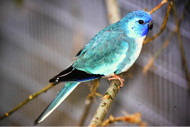Grass Parakeets (Neophema) Fact Sheet
Posted by Grass Parakeets facts, Neophema facts, Parrot facts on 9/1/2024
In this article Rosemary Low explains about interesting facts about Grass Parakeets (Neophema), including origin, food, colouring, breeding, housing and more.
Common names in Australia:
(where different) Scarlet-chested Parrot, Turquoise Parrot.
Adult length:
20-22cm. As they are a similar size to a Budgie, here are the products that may be suitable for them.
Adult weight:
40-50g.
Potential lifespan:
about 20 years.
Status in wild:
Splendid:
scarce.
Turquoisine:
Near-threatened.
Elegant:
locally common.
Blue-winged:
fairly common.
Rock:
found only along the coast, where fairly common in some areas.
Orange-bellied (N.chrysogaster):
Critically endangered ? the most threatened bird in Australia with only 50 known in the wild.

Captive breeding (under the auspices of the Orange-bellied Parrot Recovery Team of the government) started in the late 1980s when captive-bred birds were released ? but this action did not increase the wild population.
Aviary breeding has been less successful in recent years and a last-ditch effort to catch a few wild birds is being made in an attempt to enlarge the gene pool and increase fertility. Sadly, the wild population has been in steep decline for decades. A migratory species, it breeds in Tasmania and migrates to the coast of South Australia and western Victoria, where most of its habitat has been destroyed.
Origin of genus
Australia with little overlap in range.
Threats
Degraded and destroyed habitat, resulting in reduced food availability.
In the Aviary
Neophemas are among the most popular of all Parrots with breeders. They are charming, quiet and inoffensive and often become very tame. They do not have potential as companion birds.

Sexing
Varies from obvious (the female Splendid has the breast green, not red and the female Turquoisine has less blue on the head and face and lacks the dark red wing patch) to more subtle (the female Elegant is slightly less colourful, also the female Blue-winged in which the primaries are jet black in the male and brownish-black in the female).
The underside of the wing is also an indication of sex as the female has a whitish spot in the middle of each flight feather which forms a line when the wing is opened. This is very faintly indicated in males.
Young birds
Start to moult as early as nine or ten weeks, when only the body feathers are moulted. Young then resemble adults except for the lesser depth of colour, and can then be sexed. Flight and tail feathers are replaced in their second year, when full adult plumage is acquired.
There is no strong pair bond in these birds, so males and females can be housed separately until they are paired up.
Accommodation
In northern Europe it is very important to protect Neophemas from cold, damp conditions. The aviary should have an enclosed part in which they can be shut at night and in damp weather.
Breeders say that a good size for an aviary is 2m long as these birds are not strong flyers. Recommended size for a breeding cage is 1.5m to 2m long, 60cm wide and 1.2m high. Neophemas do not want to fly vertically in a small space.
Breeding cages are best raised at least 90cm above ground. Tiered cages with the bottom cage at floor level should not be used. No bird should have a constant view of human legs and possible exposure to draughts.
There are loads of great cages to pick from here.
Feeding
Small Parakeet mixture, with limited or no sunflower seed plus soaked or sprouted small striped sunflower and sprouted Canary mixture will form the basis of the diet.
Millet sprays are enjoyed, also slices of apple.
Plenty of wild foods will be eaten, especially seeding grasses, chickweed and smooth sow thistle, plus oats and wheat in the green stage.
Egg food and soaked oats should be provided just before and during the breeding season. From June until September green and/or seeding dock can be offered.
Breeding
Recommended nest-box size is 15cm square and 25cm high. To make it more attractive, darker and draught-proof, search for a piece of hollow branch and attach it to the entrance.
Wood shavings (especially those in packs of compressed pet litter) to a depth of about 4cm should be placed on the bottom of the box. Most Neophemas start to breed when one year old. The usual clutch size is four to six, sometimes more.
Incubation is carried out by the female for 18 or 19 days and usually commences with the second egg. Chicks are brooded closely for about ten days and should be ringed with size L (4.3mm) rings.
Young leave the nest at about 30 days. Some females lay a second clutch as soon as or even before the young fledge. The nest-box should be removed immediately the young from the second nest fledge ? or the first nest of young if the first eggs failed. This prevents the female trying to nest again when it is time for her to moult.
Newly fledged young can injure themselves in an aviary by flying into the wire so plenty of branches should be placed in front of the welded mesh. However, cage breeding is practiced widely these days and this does not always produce the best quality young.
The preference of many breeders for mutations has resulted in pure-bred stock of the original colour of Splendid and Turquoisine Parakeets being difficult to find ? which is regrettable.



